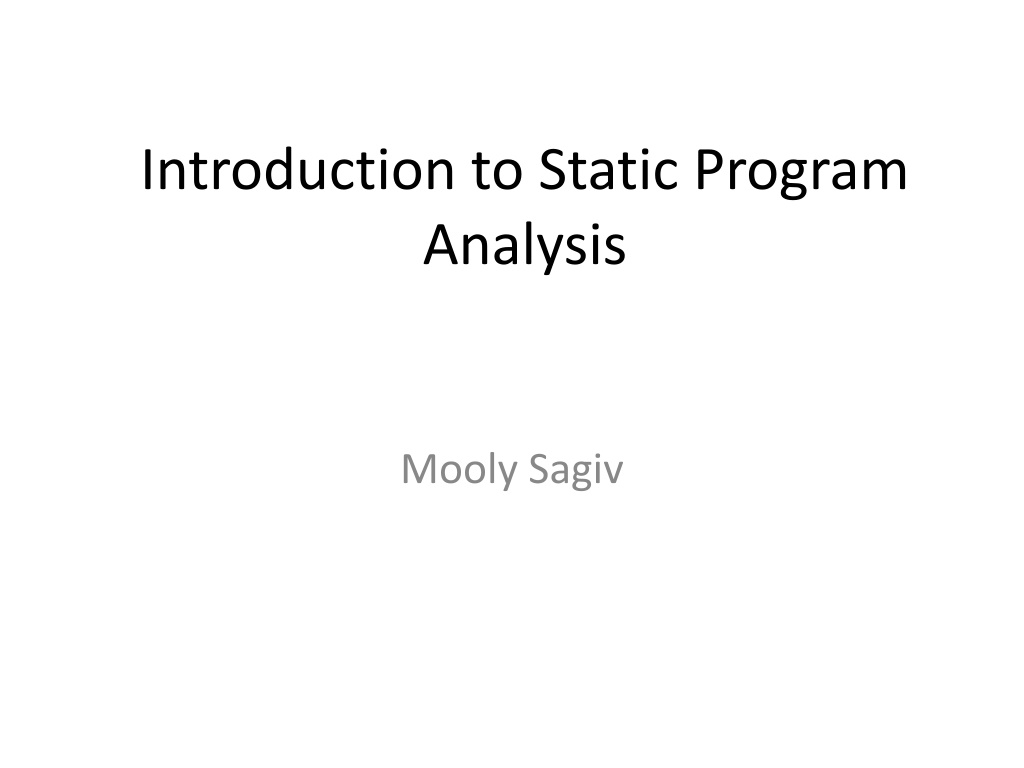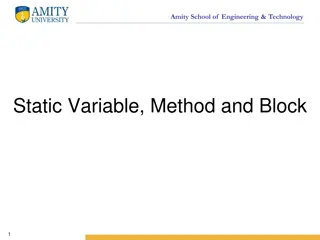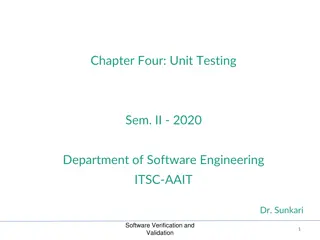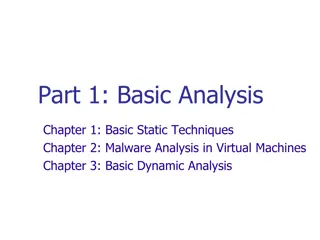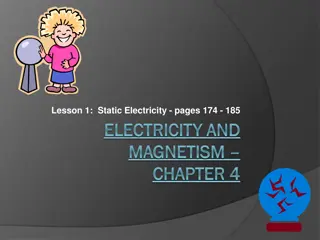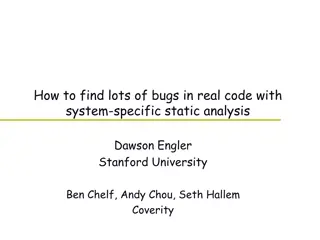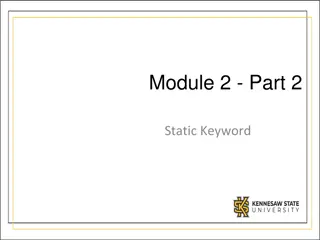Understanding Static Program Analysis
Static program analysis involves proving correctness, inferring invariants, and detecting errors in code before execution. Challenges include specifying program behavior, writing loop invariants, and using decision procedures for implications. This analysis can help ensure code reliability and identify potential bugs before runtime.
Download Presentation

Please find below an Image/Link to download the presentation.
The content on the website is provided AS IS for your information and personal use only. It may not be sold, licensed, or shared on other websites without obtaining consent from the author. Download presentation by click this link. If you encounter any issues during the download, it is possible that the publisher has removed the file from their server.
E N D
Presentation Transcript
Introduction to Static Program Analysis Mooly Sagiv
Challenges in Proving Correctness Specifying what the program is supposed to do Writing loop invariants Decision procedures for proving implications Deduction
Static Analysis Automatically infer sound invariants from the code Prove the absence of certain program errors Prove user-defined assertions Report bugs before the program is executed
Simple Correct C code main() { int i = 0, *p =NULL, a[100]; for (i=0 ; i <100, i++) { a[i] = i; p = malloc(1, sizeof(int)); *p = i; free(p); // not alloc(p) p = NULL; // no leak }
Simple Correct C code main() { int i = 0, *p=NULL, a[100]; for (i=0 ; i <100, i++) { { 0 <= i < 100} a[i] = i; { p == NULL:} p = malloc(1, sizeof(int)); { alloc(p) } *p = i; {alloc(p)} free(p); {!alloc(p)} p = NULL; {p==NULL} }
Simple Incorrect C code main() { int i = 0, *p=NULL, a[100], j; for (i=0 ; i <j , i++) { { 0 <= i < j} a[i] = i; p = malloc(1, sizeof(int)); { alloc(p) } p = malloc(1, sizeof(int)); { alloc(p) } free(p); free(p); }
Sound (Incomplete) Static Analysis It is undecidable to prove interesting program properties Focus on sound program analysis When the compiler reports that the program is correct it is indeed correct for every run The compiler may report spurious (false alarms)
A Simple False Alarm int i, *p=NULL; if (i >=5) { p = malloc(1, sizeof(int)); } if (i >=5) { *p = 8; } if (i >=5) { free(p); }
A Complicated False Alarm int i, *p=NULL; if (foo(i)) { p = malloc(1, sizeof(int)); } if (bar(i )) { *p = 8; } if (zoo(i)) { free(p); }
Foundation of Static Analysis Static analysis can be viewed as interpreting the program over an abstract domain Execute the program over larger set of execution paths Guarantee sound results Whenever the analysis reports that an invariant holds it indeed hold
Even/Odd Abstract Interpretation Determine if an integer variable is even or odd at a given program point
Example Program /* x=? */ while (x !=1)do { if(x %2) == 0 assert (x %2 ==0); } } /* x=? */ /* x=? */ { x := x / 2; } else { x := x * 3 + 1; /* x=E */ /* x=O */ /* x=E */ /* x=O*/
Lattice of Values ? O E
Abstract Interpretation Abstract Concrete Sets of stores Descriptors of sets of stores
Odd/Even Abstract Interpretation All concrete states ? {-2, 1, 5} {x: x Even} {0,2} E O {0} {2}
Odd/Even Abstract Interpretation All concrete states ? {-2, 1, 5} {x: x Even} {0,2} E O {0} {2}
Odd/Even Abstract Interpretation All concrete states ? {-2, 1, 5} {x: x Even} {0,2} E O {0} {2}
Example Program while (x !=1)do { if (x %2) == 0 assert (x %2 ==0); } } { x := x / 2; } else { x := x * 3 + 1; /* x=O */ /* x=E */
(Best) Abstract Transformer Operational Semantics Concrete Representation Concrete Representation St Concretization Abstraction St Abstract Representation Abstract Representation Abstract Semantics
(Best) Abstract Transformer x := 3*x + 1 Concrete Representation Concrete Representation St Concretization Abstraction x := 3*x + 1 St Abstract Representation Abstract Representation x := if x = then else if x = ? then ? else if x =O then E else O
(Best) Abstract Transformer x := 3*x + 1 - , , -1,0, 1,2 , - , , -2,1, 7, , St Concretization Abstraction x := 3*x + 1 St ? ? x := if x = then else if x = ? then ? else if x =O then E else O
(Best) Abstract Transformer x := 3*x + 1 - , , -2 ,0, 2, 4 , - , , -5,1, 7, , St Concretization Abstraction x := 3*x + 1 St E O x := if x = then else if x = ? then ? else if x =O then E else O
(Best) Abstract Transformer x := 3*x + 1 - , , -1 , 1, 3 , - , , -2,4, 10, , St Concretization Abstraction x := 3*x + 1 St O E x := if x = then else if x = ? then ? else if x =O then E else O
Runtime vs. Static Testing Runtime Static Analysis Effectiveness Missed Errors False alarms Locate rare errors Cost Proportional to program s execution Proportional to program s size No need to efficiently handle rare cases Can handle limited classes of programs and still be useful
Static Analysis Algorithms Generate a control flow graph Collecting semantics define the reachable states Generate a system of equations over the abstract values at every node Iteratively compute the simultaneous least solution at every node The solution is guaranteed to be sound Abstracts the set of reachable states Computes an inductive invariant May not be strong enough The correctness of the safety properties can be conservatively checked
Example Interval Analysis Find a lower and an upper bound of the value of a single variable Can be generalized to multiple variables
Simple Correct C code main() { int i = 0, a[100]; { [-minint, maxint] } for (i=0 ; i <100, i++) { {[0, 99]} a[i] = i; {[0, 99]} } {[100, 100]}
The Power of Interval Analysis int f(x) { {[minint , maxint]} if (x > 100) { {[101, maxint]} return x -10 ; {[91, maxint-10];} } else { {[minint, 100] } return f(f(x+11)) { [91, 91]} }
Example Program Interval Analysis n1 x := 1 ; while x 1000 do x := x + 1; x :=1 assume x>1000 n2 n4 x :=x+1 assume x 1000 n3
Example Program Interval Analysis [- , ] n1 x := 1 ; while x 1000 do x := x + 1; x :=1 [1001, 1001] assume x>1000 [1, 1001] n2 n4 x :=x+1 assume x 1000 [1, 1000] n3
Collecting Interpretation Defines the set of reachable states as the least solution to a systems of equations Uniquely defined But not necessarily computable
Collecting Semantics (Example) - , , -1, 0, 1, n1 x :=1 1001 1,2, , 1001 assume x>1000 n2 n4 assume x 1000 x :=x+1 1,2, , 1000 n3
Collecting Semantics (Example) n1 CS[n1] =Z CS[n2] = x := 1 CS[n1] x := x+1 CS[n3] CS[n3] = assume x 1000 CS[n2] CS[n4] = assume x>1000 CS[n2] x :=1 assume x>1000 n2 n4 assume x 1000 x :=x+1 n3 :2Z 2Z CS[n1] Z CS[n2] {x |1 x 1001} CS[n3] {x |1 x 1000} CS[n4] {1001} x := 1 = w.{1} x := x+1 = w.{z+1 | z w } assume x>100 = w. assume x 100 = w. {x |1 x 1000} {x |x 1000} {x |1 x 1001} {x |x 1001} Z {1002} Z {1001]
Abstract Interpretation of Joins then else l1 u1 l2 u2 min l1, l2 max u1,u2 [l1, u1] [l2, u2] =[min(l1, l2), max (u1, u2)]
Abstract Interpretation of Meets assume assume l1 u1 l2 u2 max l1, l2 min u1,u2 [l1, u1] [l2, u2] =[max(l1, l2), min (u1, u2)]
Abstract Interpretation of Atomic Statements skip#[l, u] = [l, u] x := 1#[l, u] = [1, 1] x := x + 1#[l, u] = [l, u] + [1, 1] = [l + 1, u + 1] assume x k#[l, u] = assume x k#[l, u] =
Interval Analysis n1 DF[n1] =[- , ] DF[n2] = x := 1#DF[n1] x := x+1# DF[n3] DF[n3] = assume x 100 # DF[n2] DF[n4] = assume x>100 # DF[n2] x :=1 assume x>1000 n2 n4 assume x 1000 x :=x+1 n3 #:Z Z Z Z x := 1#= w.[1, 1] x := x+1#= [l, u]. [l+1, u+1] assume x>100#= w. assume x 100#= w. DF[n1] [- , [ DF[n2] ]1,1001] DF[n3] [1, 1000] DF[n4] [1001, 1001] [- , ] [1, 1000] [x |x 1000] [1, 1001] {x |x 1001} {1002} Z {1001]
Solving the Equations For programs with loops the equations have many solutions Every solution is sound Compute a minimal solution
An Example with Multiple Solutions DF(n1) = [- , ] n1 x:=1 DF(n2) = x:=1 # DF(n1) skip # DF(n3) n2 DF(n3) = skip # DF(n2) skip skip n3 DF[n1] DF[n2] DF[n3] Comments [- , ] [- , ] [- , ] [- , ] [- , ] [- , ] Maximal [1, 1] [1, 1] Minimal [1, 2] [1, 2] Solution [1, 1] [1, 2] Not a solution
Computing Minimal Solution Initialize the interval at the entry according to program semantics Initialize the rest of the intervals to empty Iterate until no more changes
Iterations Interval Analysis n1 x :=1 assume x>1000 n2 n4 assume x 1000 x :=x+1 N DF[n1] DF[n2] DF[n3] DF[n4] [- , ] n3 n1 n2 [1,1] n3 [1, 1] n2 [1, 2] n3 [1, 2]
Iterative Algorithm Chaotic(G(V, E): Graph, s: Node, L: Lattice, : L, f: E (L L) ){ for each v in V to n do DF[v] := df[v] = WL = {s} while (WL ) do select and remove an element u WL for each v, such that. (u, v) E do temp = f(e)(DF[u]) new := DF[v] temp if (new DF[V]) then DF[v] := new; WL := WL {v}
Iterations Interval Analysis n1 x :=1 assume x>1000 n2 n4 assume x 1000 x :=x+1 n3 N DF[n1] DF[n2 ] DF[n3] DF[n 4] WL [- , ] {n1, n2, n3, n4} n1 n2 [1,1] {n2, n3, n4} n3 [1, 1] {n2, n4} n2 [1, 2] {n3, n4} n3 [1, 2] {n2, n4}
Fixed Points f( ) f2( ) A monotone function f: L L where (L, , , , , ) is a complete lattice Fix(f) = { l: l L, f(l) = l} Red(f) = {l: l L, f(l) l} Ext(f) = {l: l L, l f(l)} l1 l2 f(l1 ) f(l2 ) Tarski s Theorem 1955: if f is monotone then: lfp(f) = Fix(f) = Red(f) Fix(f) gfp(f) = Fix(f) = Ext(f) Fix(f) Red(f) gfp(f) Fix(f) lfp(f) f2( ) Ext(f) f( )
a: f((a)) (f#(a)) f( ) f#( ) f2( ) f#2( ) f(x) x f#(y) y gfp(f) gfp(f#) f(x)=x f#(y)=y lfp(f) lfp(f#) f2( ) f#2( ) f(x) x f#(y) y f( ) f#( )
Finite Height Case f Lfp(f) Lfp(f#) f# f f# f# f
Accelerating Convergence The Iterative algorithm can diverge when the domains contains infinite increasing chains Sometimes can take long time
Widening Accelerate the convergence of the iterative procedure by jumping to a more conservative solution Heuristic in nature But simple to implement
